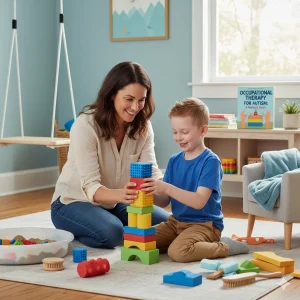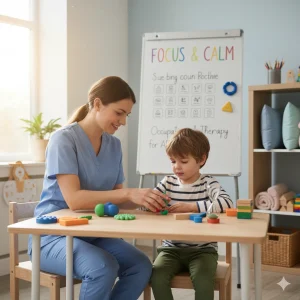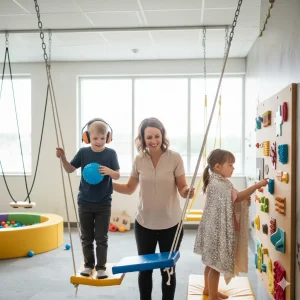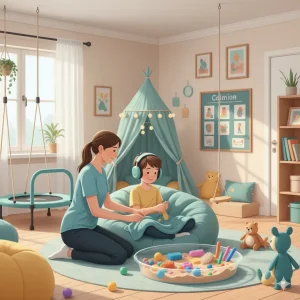Why Social Stories for ASD are Important?
Last Updated: January 24, 2025
Autism Spectrum Disorder (ASD) presents unique challenges in social communication, making everyday interactions daunting for those affected. Social stories are tailored narratives designed to clarify social norms and behaviors, aiding individuals with ASD in understanding and navigating social situations. This article offers parents, educators, and therapists insights into the practical uses of social stories to enhance communication skills. By exploring their benefits, we aim to empower caregivers and professionals with effective strategies to support their loved ones or students.
Social Stories for ASD
Explore how social stories can support children with autism and ADHD. Learn more about their impact and how to use them effectively.
Download NowWhat Are Social Stories?
Social stories are short guides that help individuals with Autism Spectrum Disorder (ASD) understand social interactions. These stories describe specific situations, explaining what to expect and why certain behaviors are expected. They are written using simple, clear language and often include pictures to help explain the concepts better. Each story focuses on particular social cues and provides a step-by-step explanation on how to respond.
Examples of Social Stories for ASD
Illustration: Kids playing together and sharing toys.
Greeting Someone New:
Story: “When I meet someone new, I look at them and say, ‘Hello.’ This is how I start talking to them. It makes people happy and helps me make friends.”
Illustration: A picture of a child waving and smiling at someone.
Sharing Toys:
Story: “It’s good to share my toys when I play with others. I can say, ‘Do you want to play with this toy?’ Sharing makes playtime fun for everyone.”
The Role of Social Stories in ASD Therapy
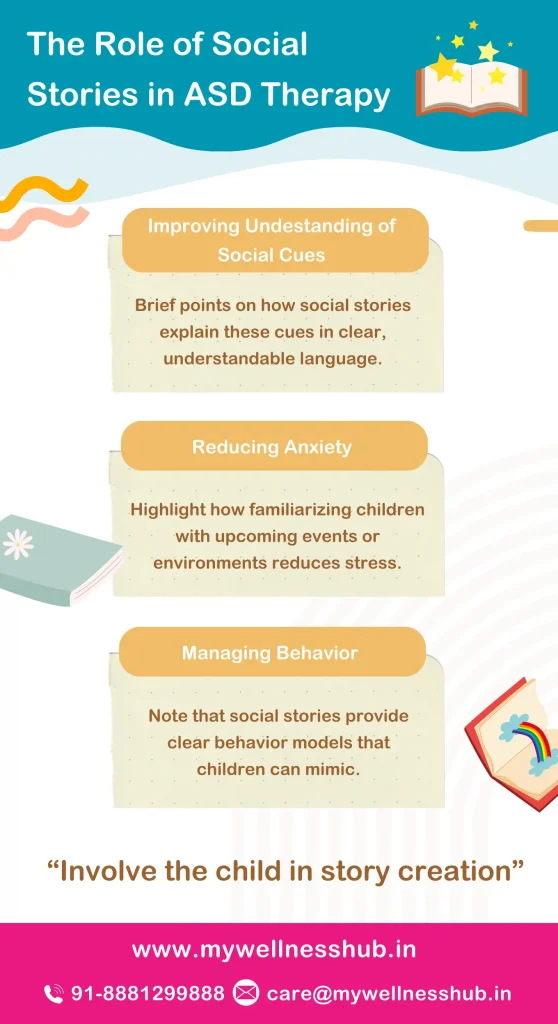
How Social Stories Improve Understanding of Social Cues
Social stories help children with Autism Spectrum Disorder (ASD) understand what to do in social situations. These stories explain social cues clearly, like how to wait your turn or say “please” and “thank you.” By reading these stories, children learn how to act in different settings, which helps them get along better with others.
Social Stories as a Tool for Behavior Management
Social stories also help manage behavior. They prepare children for new or stressful situations by explaining what will happen and how they should behave. For example, a story about visiting the dentist can make the experience less scary by showing what to expect step by step. This can help children feel more relaxed and behave better during these times.
Benefits of Social Stories for Children with Autism
Enhancing Social Skills Through Tailored Narratives
- Customized Learning: Each social story is tailored to teach specific social behaviors, like sharing or saying “thank you.”
- Practical Application: Children practice through stories, improving their ability to interact during school activities and playdates.
Reducing Anxiety and Improving Behavior Predictability
- Preparation: Social stories prepare children for new situations, such as visiting a dentist or going to a birthday party.
- Reduced Anxiety: Knowing what to expect helps children feel less anxious and behave more predictably in unfamiliar situations.
Case Studies or Testimonials on Effectiveness
- Real-life Success: Case studies show how social stories have helped children understand classroom rules or manage transitions.
- Positive Feedback: Testimonials from parents and teachers highlight improved social interactions and reduced stress in children.
How to Create Effective Social Stories
Key Elements of a Successful Social Story
Creating a successful social story involves understanding and implementing key elements that make the narratives effective and engaging for children with Autism Spectrum Disorder (ASD). Here are the essential components to include:
- Simple Language: Use clear, concise language that the child can easily understand. Avoid metaphors and keep sentences short.
- First-Person Perspective: Write from the child’s perspective to help them relate directly to the scenarios.
- Visual Supports: Include pictures or symbols that support the text, as many children with ASD are visual learners.
- Descriptive, Directive, and Perspective Sentences:
- Descriptive sentences explain the situation or the setting.
- Directive sentences gently guide the child on what to do.
- Perspective sentences describe the emotions and reactions of others involved.
- Positive Tone: Focus on positive behaviors and outcomes to encourage the child and reinforce good behavior.
Tips for Customizing Social Stories to Individual Needs
Each child with ASD is unique, which means social stories need to be tailored to their specific needs and understanding levels. Here’s how to customize effectively:
- Assess the Child’s Interests: Incorporate elements that the child is interested in to increase engagement. For example, if a child likes trains, a social story about waiting in line could be set at a train station.
- Involve the Child in the Creation: Whenever possible, let the child help create the story. This can make the story more relevant and interesting to them.
- Specificity: Tailor the story to address specific situations the child struggles with, rather than generic scenarios.
- Feedback and Revision: Use feedback from caregivers and teachers to refine the story. If a particular part of the story does not seem to resonate or work as intended, adjust it.
- Consistent Review: Regularly revisit and update the story as the child’s skills and needs evolve.
Integrating Social Stories into Daily Routines
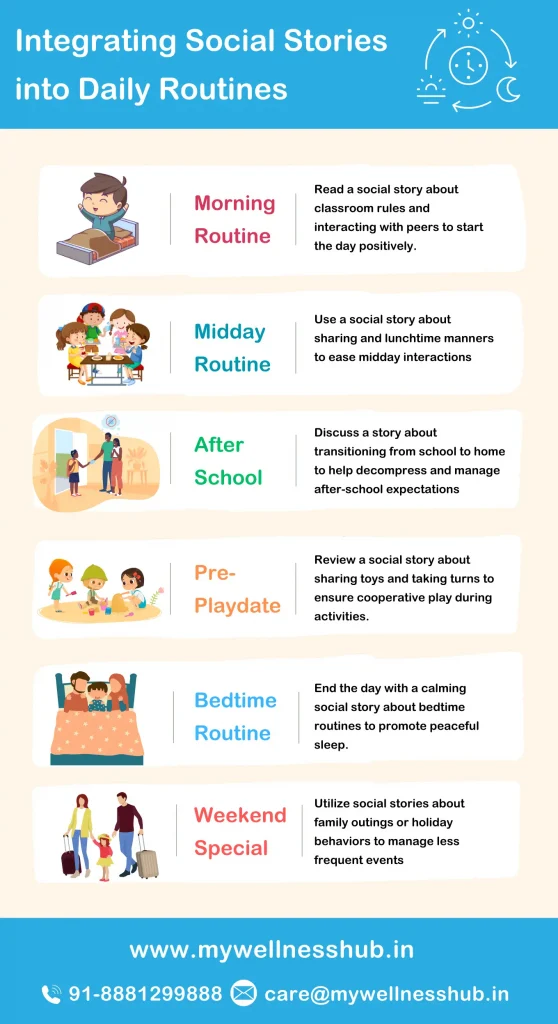
Practical Advice on When and How to Use Social Stories Daily
Incorporating social stories into the daily routine of a child with Autism Spectrum Disorder (ASD) can greatly enhance their ability to understand and manage social interactions. Here’s how to make social stories a regular part of their day:
- Consistent Timing: Choose a regular time for reading social stories, such as during breakfast or just before a common challenging situation like going to school.
- Relevance: Use stories that are immediately relevant. For example, if your child will be attending a birthday party, read a social story about party etiquette or sharing before the event.
- Repetition: Repetition is key to learning for children with ASD. Revisit the same story multiple times until the child is comfortable with the scenario and what they’re expected to do.
- Integration with Activities: Pair the reading of social stories with related activities. For instance, a story about playing nicely can be followed by a play session where the child practices the behaviors described.
Daily Schedule for Integrating Social Stories
| Time | Activity | Social Story Topic | Purpose |
|---|---|---|---|
| 7:00 AM | Preparing for School | Classroom Behavior and Peer Interaction | Helps set positive expectations for the school day. |
| 12:00 PM | Lunchtime at School | Sharing and Lunchtime Manners | Encourages proper social interaction during lunch. |
| 3:30 PM | Coming Home from School | Transitioning Home | Eases the shift from school environment to home. |
| 4:30 PM | Before Playdates or Activities | Sharing Toys and Taking Turns | Prepares for cooperative play and social exchanges. |
| 7:30 PM | Bedtime | Bedtime Routines | Promotes a calm and structured end to the day. |
| Weekends | Special Occasions (Variable) | Family Outings and Holiday Behaviors | Addresses behaviors for less frequent, special events. |
Engaging Children with ASD in Social Story Sessions
To keep children engaged during social story sessions and maximize their effectiveness, consider the following strategies:
- Interactive Reading: Make the sessions interactive by asking questions and encouraging the child to guess what might happen next or how the characters might feel.
- Use of Props: Incorporate props or visual aids that relate to the story. This can help bring the story to life and make it more tangible for the child.
- Role-Playing: After reading a story, role-play the scenario with the child. This helps them practice the behaviors in a safe and controlled environment.
- Positive Reinforcement: Provide positive feedback and rewards after the session to reinforce good behavior and participation. This could be verbal praise or a small reward like a sticker.
Conclusion
Social stories are a fantastic way to help those with Autism Spectrum Disorder (ASD) understand social rules and manage interactions. These stories simplify complex behaviors into clear, relatable scenarios, making everyday situations easier for individuals with ASD. We encourage everyone to try creating and using social stories to see their benefits firsthand. Interested in learning more or need help getting started? Visit Wellness Hub for easy-to-use resources and expert advice.
Frequently Asked Questions:
1. What are social stories for autism?
Social stories are specially designed narratives that explain social interactions, situations, and behaviors through simple, structured text. They aim to help children with autism understand social cues and practices by depicting specific scenarios they might encounter in daily life.
2. How do social stories help children with ASD?
These stories equip children with a clearer understanding of how to behave in social settings by explicitly describing the behavior and the reasons behind it. This targeted guidance helps children with ASD anticipate what’s expected of them, reducing confusion and stress.
3. Can social stories reduce anxiety for children with autism?
Yes, social stories can significantly lessen anxiety for children with autism by familiarizing them with social dynamics and outcomes. Knowing what to expect in various situations makes these encounters less intimidating and more manageable.
4. What is the best time to use social stories?
Ideal times include before transitions or new experiences (like visiting a dentist or attending a birthday party). Regularly incorporating social stories into your daily routine, such as during breakfast or bedtime, can also reinforce learning and preparation.
5. How often should I read social stories to my child?
Frequency can depend on the child’s needs and the situations they are preparing for. Reading a relevant social story multiple times before a particular event can help reinforce the behavior and expectations described.
6. Can I make my own social stories for my child?
Creating personalized social stories can be very effective. Personalize stories to include your child’s specific challenges and interests, using familiar language and scenarios, which can make the story more relatable and impactful.
7. What should a good social story include?
Effective social stories should contain:
- Clear, concise descriptions of social situations.
- Information on why certain behaviors are expected.
- Positive reinforcement messages to encourage proper social behavior.
- Visual aids to support the text and engage visual learners.
8. Are there any tools to help create social stories?
Yes, there are online platforms and resources like Wellness Hub that provide templates, guidelines, and tips for creating engaging and effective social stories. These tools often offer customizable options to suit individual needs.
9. How do I know if social stories are working for my child?
You might notice a reduction in behavioral issues and an increase in appropriate social interactions. Feedback from teachers and other caregivers can also provide insights into improvements in understanding and adapting social behaviors.
10. Where can I find examples of social stories?
Wellness Hub’s website offers a diverse collection of social stories designed for various situations and behaviors. These resources include downloadable templates and examples that can be customized to meet specific needs.
About the Author:
Shravanaveena Gajula
M.Sc ., Speech and Language Pathology (5+ years of experience)
Shravanaveena Gajula is a dedicated Audiologist and Speech-Language Pathologist with a BASLP and an M.Sc in Speech and Language Pathology. With experience spanning multiple settings, including Wellness Hub and Ashray Akruti, Veena specializes in a wide range of disorders from developmental issues in children to speech and language assessments in adults. Her expertise includes parent counseling, managing speech sound and fluency disorders, and creating individualized therapy programs. Veena is also PROMPT certified and an author of several insightful blogs on speech and language pathology, aiming to educate and assist caregivers in supporting their loved ones.
Book your Free Consultation Today
Parent/Caregiver Info:
Client’s Details:
* Error Message


